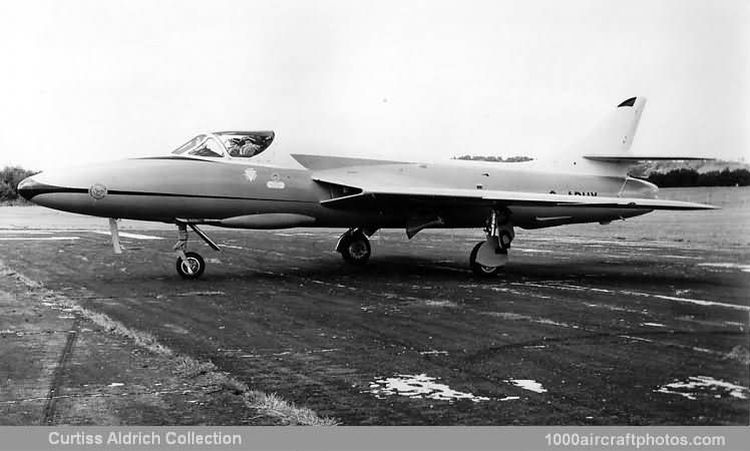03/31/2011. Remarks by Johan Visschedijk: "The sole T.Mk.66A built, this aircraft was a hybrid, a new nose section from the T.Mk.66 production line, married to parts of two damaged Belgian F.Mk.6s. The middle and rear fuselage were used from a crashed F.Mk.6s that was originally license-build by SABCA (Société Anonyme Belge de Construction Aéronautique) of Belgium in 1957, under the serial IF19 (c/n 8763). The aircraft was taken on charge on January 8, 1958, and two days later assigned to No. 7 Wing at Chièvres.
Just eight weeks later, March 21, the pilot Adjudant Masselis bailed out after IF-19 had suffered a flame-out at 1,500 ft (457 m), while on approach to Chièvres. Much to the unhurt pilot's subsequent embarrassment the aircraft made a wheels-up landing in a local field. In so doing it killed two horses, felled two trees, and penetrated a stone wall, before it finally came to rest astride a road. IF19 was struck off charge on July 4, 1958, after only 24 hr 5 min flying time.
The wings, tail and rudder for the T.Mk.66A came from the F.Mk.6 with serial IF67 (c/n 8817). Also produced by SABCA that aircraft was taken on charge on April 22, 1958 and was also operated from Chièvres, alternating between No,7 and No. 9 Wing. This aircraft suffered a starter explosion on January 29, 1959, and was struck off charge on June 12, 1959, after 191 hr 35 min flying time.
Hawker acquired the salvaged parts and during July and August 1959, and used them to complete the T.Mk.66A, which had been registered G-APUX on June 24. Painted red and white with black trim, it differed from the standard T.Mk.66 by having Dunlop Maxaret nose wheel braking and a larger braking parachute. After its maiden flight the aircraft was granted a CofA on September 4, 1959 and immediately made its public debut at Farnborough for the SBAC Display, where test pilot Bill Bedford demonstrated, on each day, the spin performance of the Hunter by using a smoke generator to trace up to sixteen spirals in a spin over the airfield.
In October 1959 G-APUX was flown to Switzerland for evaluation trials, during the course of which it put in some service with No. 8 Squadron, Swiss AF, training pilots for the new Hunter F.Mk.58s. It returned to Hawker in the summer of 1960 and was then fitted with nose wheel steering, windscreen wipers, ADF and DME, and on September 3 was first flown with a pair of lengthy 420.3 gal (1,591 l) ferry tanks. These it took to Farnborough for the 1960 SBAC Display where again it was put through the spin demonstration. During 1961 G-APUX repeated this performance at the Hanover, Paris, and Farnborough Displays and again in 1962.
However, by the end of that year Hawker's need for a Hunter demonstrator was not so great and customer demand was already beginning to exceed supply. One of the new customers was Iraq who was awaiting delivery of its own T.Mk.69s. In the spring of 1963 Hawkers agreed to loan the T.Mk.66A for six months and accordingly the Hunter was repainted in a standard gloss camouflage scheme with Iraqi markings and the serial 567. It first flew at Dunsfold in the new colours on May 24, 1963 and left for Iraq on its delivery flight on the 30th; the civil registration was cancelled on the same day. The Iraqi T.Mk.69 with serial 567 was delivered on February 24, 1965 but in the meantime the T.Mk.66A had been sub-loaned by Iraq to Jordan (without any insignia at all), and to the Lebanon, where it was serialed L581.
Hawkers eventually went out to collect the aircraft, which returned direct from the Lebanon to Dunsfold on December 18, 1965, to stand for some time in storage. During 1966 it was given the 'Class B' marking G-9-232, stripped down and completely rebuilt as a T.Mk.72 for the Chilean AF. It flew again on June 27, 1967 and shortly afterwards was given a camouflage top coat, Chilean insignia and the new serial J-718. On August 9 it was delivered to No. 30 MU at Sealand where it was broken down into components for shipment from Liverpool docks to Chile.
The aircraft served with the Chilean AF for 28 years, it was withdrawn from use in 1995. Presently it is in display at the National Aeronautical Museum at Los Cerrillos airfield, Santiago."
